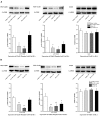Norepinephrine Induces PTSD-Like Memory Impairments via Regulation of the β-Adrenoceptor-cAMP/PKA and CaMK II/PKC Systems in the Basolateral Amygdala
- PMID: 30894805
- PMCID: PMC6414421
- DOI: 10.3389/fnbeh.2019.00043
Norepinephrine Induces PTSD-Like Memory Impairments via Regulation of the β-Adrenoceptor-cAMP/PKA and CaMK II/PKC Systems in the Basolateral Amygdala
Abstract
Glucocorticoids (GCs) can modulate the memory enhancement process during stressful events, and this modulation requires arousal-induced norepinephrine (NE) activation in the basolateral amygdale (BLA). Our previous study found that an intrahippocampal infusion of propranolol dose-dependently induced post-traumatic stress disorder (PTSD)-like memory impairments. To explore the role of the noradrenergic system of the BLA in PTSD-like memory impairment, we injected various doses of NE into the BLA. We found that only a specific quantity of NE (0.3 μg) could induce PTSD-like memory impairments, accompanied by a reduction in phosphorylation of GluR1 at Ser845 and Ser831. Moreover, this phenomenon could be blocked by a protein kinase A (PKA) inhibitor or calcium/calmodulin-dependent protein kinase II (CaMK II) inhibitor. These findings demonstrate that NE could induce PTSD-like memory impairments via regulation of the β-adrenoceptor receptor (β-AR)-3',5'-cyclic monophosphate (cAMP)/PKA and CaMK II/PKC signaling pathways.
Keywords: AMPA; CaMK II/PKC; PTSD; basolateral amygdala; cAMP/PKA; fear conditioning; norepinephrine.
Figures





Similar articles
-
Glucocorticoids interact with the basolateral amygdala beta-adrenoceptor--cAMP/cAMP/PKA system in influencing memory consolidation.Eur J Neurosci. 2002 Feb;15(3):553-60. doi: 10.1046/j.0953-816x.2001.01876.x. Eur J Neurosci. 2002. PMID: 11876783
-
Propranolol can induce PTSD-like memory impairments in rats.Brain Behav. 2018 Jan 18;8(2):e00905. doi: 10.1002/brb3.905. eCollection 2018 Feb. Brain Behav. 2018. PMID: 29484264 Free PMC article.
-
Locus Coeruleus Norepinephrine Drives Stress-Induced Increases in Basolateral Amygdala Firing and Impairs Extinction Learning.J Neurosci. 2020 Jan 22;40(4):907-916. doi: 10.1523/JNEUROSCI.1092-19.2019. Epub 2019 Dec 4. J Neurosci. 2020. PMID: 31801809 Free PMC article.
-
Glucocorticoids interact with emotion-induced noradrenergic activation in influencing different memory functions.Neuroscience. 2006;138(3):901-10. doi: 10.1016/j.neuroscience.2005.07.049. Epub 2005 Nov 28. Neuroscience. 2006. PMID: 16310958 Review.
-
Role of norepinephrine in mediating stress hormone regulation of long-term memory storage: a critical involvement of the amygdala.Biol Psychiatry. 1999 Nov 1;46(9):1140-52. doi: 10.1016/s0006-3223(99)00157-2. Biol Psychiatry. 1999. PMID: 10560021 Review.
Cited by
-
Repeated Yueju, But Not Fluoxetine, Induced Sustained Antidepressant Activity in a Mouse Model of Chronic Learned Helplessness: Involvement of CaMKII Signaling in the Hippocampus.Evid Based Complement Alternat Med. 2022 Feb 24;2022:1442578. doi: 10.1155/2022/1442578. eCollection 2022. Evid Based Complement Alternat Med. 2022. PMID: 35251201 Free PMC article.
-
Amphetamine Modulation of Long-Term Object Recognition Memory in Rats: Influence of Stress.Front Pharmacol. 2021 Feb 24;12:644521. doi: 10.3389/fphar.2021.644521. eCollection 2021. Front Pharmacol. 2021. PMID: 33716754 Free PMC article.
-
Effects of Social Isolation on Perineuronal Nets in the Amygdala Following a Reward Omission Task in Female Rats.Mol Neurobiol. 2021 Jan;58(1):348-361. doi: 10.1007/s12035-020-02125-8. Epub 2020 Sep 17. Mol Neurobiol. 2021. PMID: 32939692 Free PMC article.
-
Alpha-2 Adrenoreceptor Antagonist Yohimbine Potentiates Consolidation of Conditioned Fear.Int J Neuropsychopharmacol. 2022 Sep 28;25(9):759-773. doi: 10.1093/ijnp/pyac038. Int J Neuropsychopharmacol. 2022. PMID: 35748393 Free PMC article. Clinical Trial.
References
-
- Almaguer-Melian W., Rojas-Reyes Y., Alvare A., Rosillo J. C., Frey J. U., Bergado J. A. (2005). Long-term potentiation in the dentate gyrus in freely moving rats is reinforced by intraventricular application of norepinephrine, but not oxotremorine. Neurobiol. Learn. Mem. 83, 72–78. 10.1016/j.nlm.2004.08.002 - DOI - PubMed
-
- Arguello A. A., Hodges M. A., Wells A. M., Lara H., III., Xie X., Fuchs R. A. (2014). Involvement of amygdalar protein kinase A, but not calcium/calmodulin-dependent protein kinase II, in the reconsolidation of cocaine-related contextual memories in rats. Psychopharmacology 231, 55–65. 10.1007/s00213-013-3203-9 - DOI - PMC - PubMed
LinkOut - more resources
Full Text Sources
Research Materials

